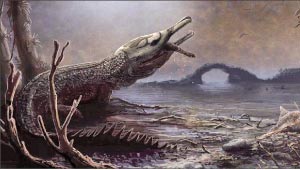The Original Headbanger?
 |
|
Above: Lemmy Kilmister at the 2015 Glastonbury Music Festival |
 |
|
Above: Lemmysuchus grooving in the Jurassic |
Scientists have named a Jurassic-era crocodile described as “one of the nastiest sea creatures to have ever inhabited the earth” after late Motorhead front man and British heavy metal icon Lemmy Kilmister.
London’s Natural History Museum says the fossil of what’s now known as Lemmysuchus Obtusidens was dug up in England in the early 20th century but was incorrectly categorized with other sea crocodiles found in the area.
Researchers recently took another look at the specimen and gave it a new classification and a scientific name of its own.
Lemmysuchus obtusidens — meaning “Lemmy’s blunt-toothed crocodile” – belonged to an extinct group of marine crocs known as teleosaurs. It lived approximately 164 million years ago in coastal waters near what is now Europe, and it measured about 19 feet (6 meters) in length and had a skull that was about 3 feet (1 m) long, according to a description in a new study.
Lemmysuchus had powerful jaws and flattened teeth that could crunch through the shells of its mollusk or turtle prey, and it would have been among the largest coastal predators at the time, study co-author Michela Johnson, a researcher with the School of GeoSciences at the University of Edinburgh in Scotland, said in a statement.
A near-complete fossil skeleton found in Peterborough, England, in 1909, part of the paleontology collection at the Natural History Museum (NHM) in London, was previously identified as Steneosaurus obtusidens, based on similarities to other known S. obtusidens fossils.
Lemmysuchus diverges most dramatically from its close relatives in the shape of its snout, according to the study. Though its nose was slender compared with that of a modern crocodile, it was shorter and rounder than was typical of teleosaurs from this time in the Jurassic. The nasal surface was “strongly convex,” and the snout made up about 62 percent of the overall skull length, the study authors reported.
The study authors determined that the fossil represented a new genus, naming it after Kilmister at the suggestion of study co-author Lorna Steel, a curator at NHM in the earth sciences department, NHM representatives said in the statement.
“We’d like to think that he would have raised a glass to Lemmysuchus, one of the nastiest sea creatures to have ever inhabited the Earth,” Steel said.